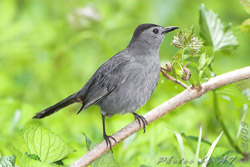
Start Your Own Habitat Garden To Attract more Birds and Butterflies
by Mitch Leachman
Executive Director
St. Louis Audubon Society
It all began almost 10 years ago, after I had moved into this my first house. A friend suggested a few plants, all Missouri natives, for a bed along the driveway. When complete, we had installed aster, coneflower, coreopsis, milkweed and penstemon, 20 plants at most, where only irises and daylilies had been previously.
Those few plants have been a source for countless fascinating and inspiring moments ever since. The asters in full fall bloom draw a myriad of native bees. I look forward to my near-daily lunch time visits from my home office to meditate with them—green ones, yellow, black or orange, honeybees and bumble bees, even blue ones—yes, I said BLUE! I take pictures, study them; they fly around and next to me. I have never been stung or ever felt threatened. I also recall the first time I saw goldfinches extracting the seed from the coneflowers toward the end of a long summer. I had just come up the driveway in the car and sat there watching, not wanting to get out and disturb them. Bird feeding by native plant—how cool is that!
In the years since, I’ve added more native plants and removed nearly all the invasive bush honeysuckle at the back of the lot. Now, instead of a plain, uniform wall of honeysuckle, I have an interesting variety of native shrubs including beautyberry, currant, ninebark and sumac. The currant is in bloom as I write, bright yellow and oh how fragrant. It is an important nectar source for early-arriving hummingbirds. The beautyberry will yield bright purple berries this fall, and I will again be on watch for the return of the catbirds and thrashers as they stop to feed on the fruit in advance of their southbound migration. The catbird got named from its “mew” call note—a sound I now anticipate through open windows in the early fall. Bird watching AND feeding courtesy of natives I planted!
I’ve known for quite some time that small patches of habitat are important for our native birds, butterflies and such. News reports, online posts and broadcasts regularly tell tales of endangered plants and animals and habitat lost to development of some sort. Then, just two years ago I was encouraged to read Bringing Nature Home by Doug Tallamy, an entomologist who has studied plant-eating insects for decades. He states that installing native plants within our personal landscapes at home and work is imperative to reverse those declines. In short, native plants provide food for native insects which are an essential protein source for 96% of all our land birds, including every Missouri songbird.
Just think about that. Cardinals, goldfinches and even hummingbirds eat insects. They must. Their babies need protein to build muscle and bone; seeds and nectar alone won’t cut it. But a juicy plant-eating caterpillar packs lots of protein, more per pound than beef.
Makes sense for a small bird to look for a tiny package of protein. Funny thing is lots of other animals eat insects, too—reptiles, amphibians, foxes, owls and even fish! Of course, the fish aren’t in most neighborhoods, but all the rest could be.
Take a look at your home, your workplace, your worship house. Is there room for a habitat garden? I started with just 60 square feet—not much at all. Are you hungry for something more in your landscape, more inspiring than turf grass or ivy? Perhaps hummingbirds and butterflies or catbirds and tree frogs. If creating a living landscape sounds daunting, there are plenty of resources available including the Bring Conservation Home program from St. Louis Audubon. Just visit www.stlouisaudubon.org/BCH for details. The birds and butterflies will thank you, and you’ll be glad you did.
For more information please contact the St. Louis Audubon Society, www.stlouisaudubon.org or call 314-599-7390.


